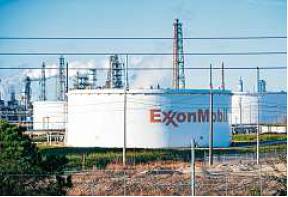Exxon plans to construct major carbon capture plant
By Shelby Webb STAFF WRITER
Exxon Mobil will build one of the world’s largest carbon capture and storage projects, as well as a new hydrogen production plant, at its refining and petrochemical site in Bay-town.
The company made the announcement Tuesday, though key details, such as a time-line and cost, are still unknown. Officials also are still deciding where they will inject the carbon dioxide into geologic formations beneath the Texas coast, said Ed Graham, vice president of ventures for Exxon Mobil Low Carbon Solutions.
The goal is for the project to transport and store up to 10 million metric tons of carbon dioxide a year, which would make it the largest project of its type in the United States, according to business data company Statista.
The hydrogen plant, meanwhile, would produce up to 1 billion cubic feet a day of hydrogen by using natural gas as a feed stock. That hydrogen would be used in Exxon’s olefins plant in Bay-town, reducing on-site emissions by up to 30 percent.
“It will be a game-changer for Houston to help kick-start both the hydrogen and (carbon capture and storage) industries,” Graham said. “This will help us more broadly decarbonize our businesses across Houston.”
Houston companies and local officials have pitched Houston as the ideal proving ground for the hydrogen industry. The city is already the largest hydrogen producer in the country, producing one-third of the annual U.S. output. There are 48 hydrogen production plants across the region and more than 900 miles of pipelines designed specifically for hydrogen — about one-third of all hydrogen pipelines globally.
In late January, Texas Sen. John Cornyn pitched a bipartisan Hydrogen Infrastructure Initiative. If passed, it would create grant programs to encourage construction of hydrogen infrastructure at ports and heavy-industry facilities and provide financing to support hydrogen transport infrastructure.
The Exxon Mobil plant would use natural gas to produce what’s known as blue hydrogen. Graham said the carbon dioxide produced from turning the natural gas into hydrogen would be captured and sequestered as part of the new carbon capture project.
Exxon Mobil’s plans to reach net-zero greenhouse gas emissions from its operations by 2050 relies heavily on carbon capture and sequestration. Last spring, executives said they were looking to build a $100 billion carbon capture project along the Ship Channel. Also last year, Exxon’s low-carbon solutions venture said it would invest $3 billion in a portfolio of 20 carbon capture projects.
Graham said Exxon already injects more carbon dioxide into the Earth than any other company. He said the projects are part of “world-scale efforts.”
“Houston and Baytown are important to us as a company, and it's important that we help lead the way and to help Houston and its efforts to be a leader in the energy transition,” Graham said. “And we think these (carbon capture) technologies and hydrogen are really critical to make that happen.” shelby.webb@chron.com
